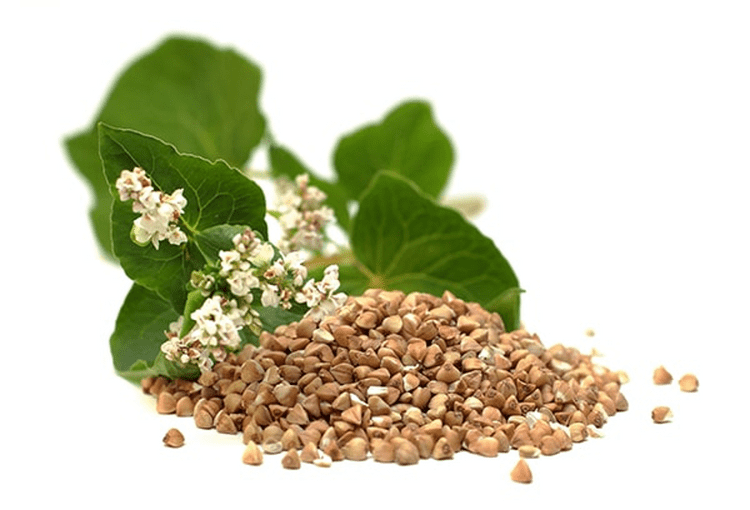BACKGROUND
Ingredient Type: Botanical
Also Known As: Fagopyrum esculentum

Buckwheat was originally grown in Asia but is now also grown in North America (1). Although there are several varieties of buckwheat, the most common type is Fagopyrum esculentum (also called common buckwheat or sweet buckwheat). This particular variety is actually not a cereal but a gluten-free knot grass closely related to rhubarb (2). Buckwheat flowers are smooth-textured and white to light pink, and they bloom from midsummer to early fall. Its seeds ripen from August to October. Over time, cultivation of buckwheat has declined in the United States but increased in Russia. Other countries, such as China, Japan, Poland, Canada, Brazil, South Africa, and Australia, also grow buckwheat.
Although buckwheat is probably best known as a source of food it also has many other uses. Its flowers are used to make antioxidant-rich honey (3). The hulls of buckwheat seeds are also commonly used in Korea and Japan to fill pillows or other bed furniture (4). Buckwheat is or has also been used as a green manure, as a plant for erosion control, and to increase the rate of pollination in orchards
TRADITIONAL USES
Coming soon
WHAT DOES SCIENCE TELL US?
Buckwheat Possibly Improves Glucose Tolerance:
Preliminary evidence suggests that consuming dietary buckwheat may improve long-term glucose tolerance in patients with diabetes (5).
Buckwheat Possibly Helps the Cardiovascular System:
Results from an epidemiological study suggest that consumption of buckwheat seed may be a preventive factor for hypertension (6). In vivo, buckwheat polyphenol (BWP) decreased nitrogen oxides that had been generated by repeated cerebral ischemia. Results from this study also suggested that BWP may improve spatial memory in rats that had undergone repeated cerebral ischemia, via inhibition of the glutamate release and the delay of mono-nitrogen oxide production (7).
Preliminary clinical research suggests that drinking a buckwheat tea for 3 months may prevent further leg swelling compared with placebo in patients with chronic venous insufficiency (8).
SAFETY
Buckwheat seed is considered safe when used orally and appropriately.
Interactions:
Moderate
- Because buckwheat may reduce blood sugar caution is advised when taking it along with antidiabetic drugs or with other herbs that have hypoglycemic potential.
Side-Effects:
- The most common adverse effects related to consumption of buckwheat or occupational exposure to buckwheat flour are related to its allergenic potential. A few reports of anaphylaxis, rhinitis, conjunctivitis, contact urticaria, skin itching, hypotension, edema, gastrointestinal symptoms, asthma, and shock have been documented (2,9).
REFERENCES
- Li SQ and Zhang QH. Advances in the development of functional foods from buckwheat. Crit Rev Food Sci Nutr. 2001;41(6):451-464.
- Plaza T and Mahler V. Anaphylactic shock due to French galette Type I allergic reaction to buckwheat. Hautarzt. 2005;56(2):160-163.
- Gheldof N and Engeseth NJ. Antioxidant capacity of honeys from various floral sources based on the determination of oxygen radical absorbance capacity and inhibition of in vitro lipoprotein oxidation in human serum samples. J Agric Food Chem. 2002;50(10):3050-3055.
- Van Ginkel CJ. Sensitisation to ‘poffertjes’ as a result of sleeping on a pillow containing buckwheat. Ned Tijdschr Geneeskd. 2002;146(13):624-625.
- Bijlani RL, Gandhi BM, Gupta MC, et al. Effect of whole buckwheat (Fagopyrum esculentum) flour supplementation on lipid profile & glucose tolerance. Indian J Med Res. 1985;81:162-168.
- Zhang HW, Zhang YH, Lu MJ, Tong WJ, Gao GW. Comparison of hypertension, dyslipidaemia and hyperglycaemia between buckwheat seed-consuming and non-consuming Mongolian-Chinese populations in Inner Mongolia, China. Clin Exp Pharmacol Physiol. 2007;34(9):838-844.
- Pu F, Mishima K, Egashira N, Iwasaki K, Kaneko T, Uchida T, Irie K, Ishibashi D, Fujii H, Kosuna K, and Fujiwara M. Protective effect of buckwheat polyphenols against long-lasting impairment of spatial memory associated with hippocampal neuronal damage in rats subjected to repeated cerebral ischemia. J Pharmacol Sci. 2004;94(4):393-402.
- Ihme N, Kiesewetter H, Jung F, Hoffmann KH, Birk A, Muller A, and Grutzner KI. Leg oedema protection from a buckwheat herb tea in patients with chronic venous insufficiency: a single-centre, randomised, double-blind, placebo-controlled clinical trial. Eur J Clin Pharmacol. 1996;50(6):443-447.
- Schumacher F, Schmid P, and Wuthrich B. Sarrazin allergy: a contribution to buckwheat allergy. Schweiz Med Wochenschr. 1993;123(33):1559-1562.
See the WebMD entry for buckwheat for more information.









